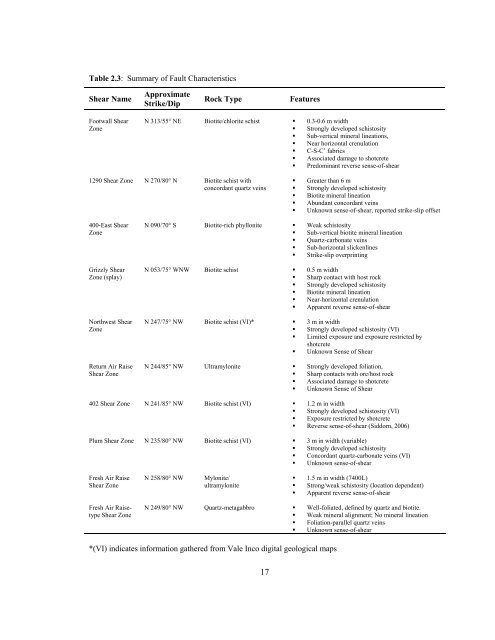title of the thesis - Department of Geology - Queen's University
title of the thesis - Department of Geology - Queen's University
title of the thesis - Department of Geology - Queen's University
Create successful ePaper yourself
Turn your PDF publications into a flip-book with our unique Google optimized e-Paper software.
Table 2.3: Summary <strong>of</strong> Fault Characteristics<br />
Shear Name<br />
Approximate<br />
Strike/Dip<br />
Rock Type<br />
Features<br />
Footwall Shear<br />
Zone<br />
N 313/55° NE Biotite/chlorite schist • 0.3-0.6 m width<br />
• Strongly developed schistosity<br />
• Sub-vertical mineral lineations,<br />
• Near horizontal crenulation<br />
• C-S-C’ fabrics<br />
• Associated damage to shotcrete<br />
• Predominant reverse sense-<strong>of</strong>-shear<br />
1290 Shear Zone N 270/80° N Biotite schist with<br />
concordant quartz veins<br />
• Greater than 6 m<br />
• Strongly developed schistosity<br />
• Biotite mineral lineation<br />
• Abundant concordant veins<br />
• Unknown sense-<strong>of</strong>-shear, reported strike-slip <strong>of</strong>fset<br />
400-East Shear<br />
Zone<br />
Grizzly Shear<br />
Zone (splay)<br />
Northwest Shear<br />
Zone<br />
Return Air Raise<br />
Shear Zone<br />
N 090/70° S Biotite-rich phyllonite • Weak schistosity<br />
• Sub-vertical biotite mineral lineation<br />
• Quartz-carbonate veins<br />
• Sub-horizontal slickenlines<br />
• Strike-slip overprinting<br />
N 053/75° WNW Biotite schist • 0.5 m width<br />
• Sharp contact with host rock<br />
• Strongly developed schistosity<br />
• Biotite mineral lineation<br />
• Near-horizontal crenulation<br />
• Apparent reverse sense-<strong>of</strong>-shear<br />
N 247/75° NW Biotite schist (VI)* • 3 m in width<br />
• Strongly developed schistosity (VI)<br />
• Limited exposure and exposure restricted by<br />
shotcrete<br />
• Unknown Sense <strong>of</strong> Shear<br />
N 244/85° NW Ultramylonite • Strongly developed foliation,<br />
• Sharp contacts with ore/host rock<br />
• Associated damage to shotcrete<br />
• Unknown Sense <strong>of</strong> Shear<br />
402 Shear Zone N 241/85° NW Biotite schist (VI) • 1.2 m in width<br />
• Strongly developed schistosity (VI)<br />
• Exposure restricted by shotcrete<br />
• Reverse sense-<strong>of</strong>-shear (Siddorn, 2006)<br />
Plum Shear Zone N 235/80° NW Biotite schist (VI) • 3 m in width (variable)<br />
• Strongly developed schistosity<br />
• Concordant quartz-carbonate veins (VI)<br />
• Unknown sense-<strong>of</strong>-shear<br />
Fresh Air Raise<br />
Shear Zone<br />
N 258/80° NW<br />
Mylonite/<br />
ultramylonite<br />
• 1.5 m in width (7400L)<br />
• Strong/weak schistosity (location dependent)<br />
• Apparent reverse sense-<strong>of</strong>-shear<br />
Fresh Air Raisetype<br />
Shear Zone<br />
N 249/80° NW Quartz-metagabbro • Well-foliated, defined by quartz and biotite.<br />
• Weak mineral alignment; No mineral lineation<br />
• Foliation-parallel quartz veins<br />
• Unknown sense-<strong>of</strong>-shear<br />
*(VI) indicates information ga<strong>the</strong>red from Vale Inco digital geological maps<br />
17

















